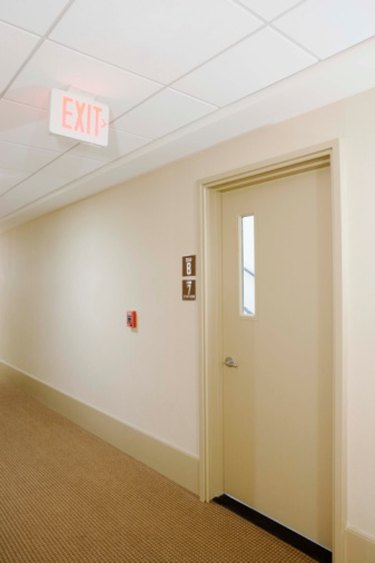
Door frames secure a door and hold it in place. Steel door frames are strong and durable alternatives to wooden door frames. However, steel door frames are susceptible to damage, including dents and rust. Repairing the damage is a requirement prior to painting. Applying paint over rust will cause the paint to bubble and peel. Applying paint over dents will highlight the dents and ruin the look of the entryway. Steel door frames come in a variety of sizes and styles, making them a good choice in both residential and commercial settings. Repairs and rust protection are necessary to extend the life of your door frame.
Remove Rust
Video of the Day
Step 1
Brush away rust with a wire brush. If the rusted area is large, attach a wire brush drill bit to a power drill to remove the rust.
Video of the Day
Step 2
Wipe the surface with a rag to remove the bits of rust.
Step 3
Sand the metal with silicon-carbide sandpaper. Begin with coarse-grit sandpaper, and progress through the grits to extra-fine grade. Progressing through the grits means using coarse-grit sandpaper, then medium-grit, then fine-grit and finally extra-fine-grit sandpaper. Using a variety of grits ensures a smooth finish.
Step 4
Dampen a rag with isopropyl alcohol and wipe the door frame to remove the sanding dust.
Repair Dents
Step 1
Sand the paint off the surface of the dent, plus 1 inch to 2 inches in all directions, using coarse-grit sandpaper.
Step 2
Apply epoxy filler with a stiff metal putty knife. Firmly press the filler into the dent and build it up to 1/8-inch higher than the frame surface.
Step 3
Allow the filler to dry completely — generally one to four hours, depending on the thickness of the filler.
Step 4
Sand the putty flush with the existing door frame. Begin with coarse-grit sandpaper and progress to extra-fine-grit sandpaper.
Repair Holes
Step 1
Sand the edges of the hole to smooth them, and remove any rust or corrosion with coarse-grit sandpaper. Sand a 1-inch surface around the hole to remove rust, oils and old paint.
Step 2
Apply epoxy filler with a putty knife to create a 1-inch border around the hole.
Step 3
Cut a piece of fiberglass mesh screen 1 inch larger than the hole in all directions. Press the screen into the epoxy filler firmly. Allow the filler to set for 30 to 45 minutes.
Step 4
Apply epoxy filler over the fiberglass mesh, building it up to slightly higher than the steel frame surface. Allow the filler to dry thoroughly, typically between one and four hours.
Step 5
Sand the epoxy filler flush with the existing surface, beginning with coarse-grit sandpaper and working your way through the grits to extra-fine-grit sandpaper.
Painting
Step 1
Sand the door frame with medium-grit sandpaper to remove old paint, grease and dirt. Sand with fine-grit and finally extra-fine-grit sandpaper. Use a sanding block or an orbital sander to strip the steel.
Step 2
Wipe the door frame with a rag dipped in isopropyl alcohol to remove all sanding dust.
Step 3
Apply a coat of rust-inhibiting metal primer with a paintbrush. Allow the primer to dry fully, usually two to four hours.
Step 4
Apply two coats of rust-inhibiting paint, using a paintbrush. Allow each coat to dry completely between applications.